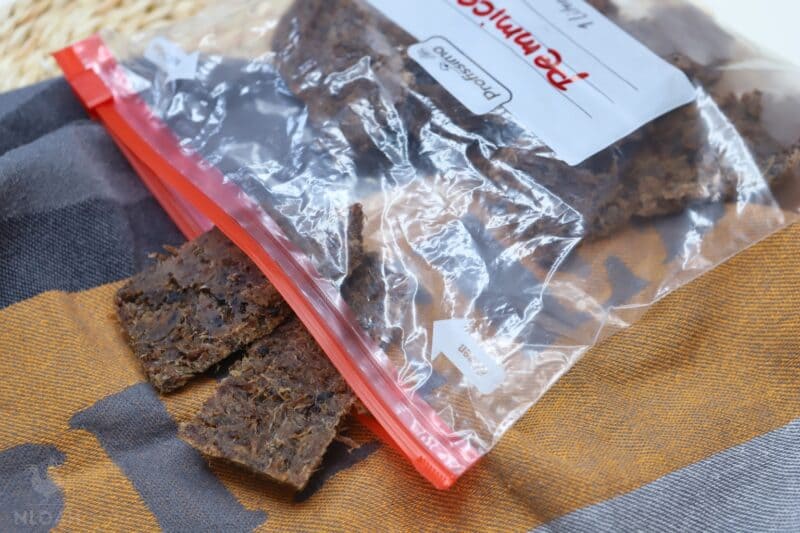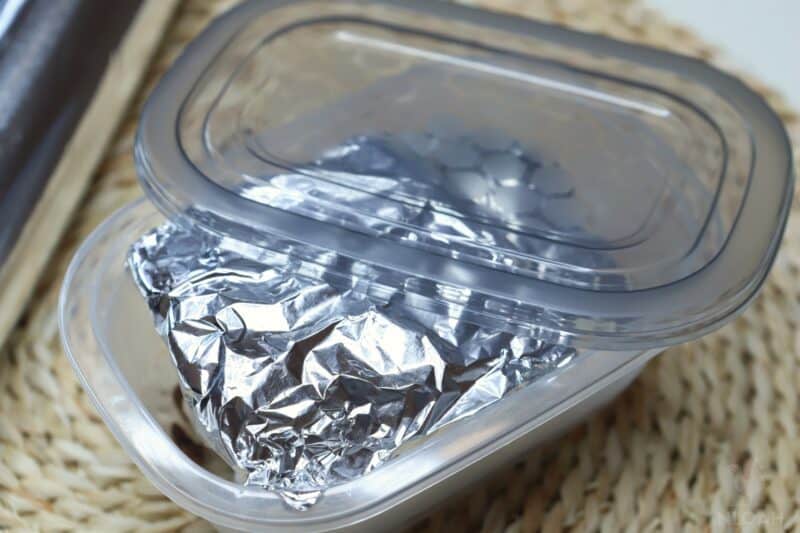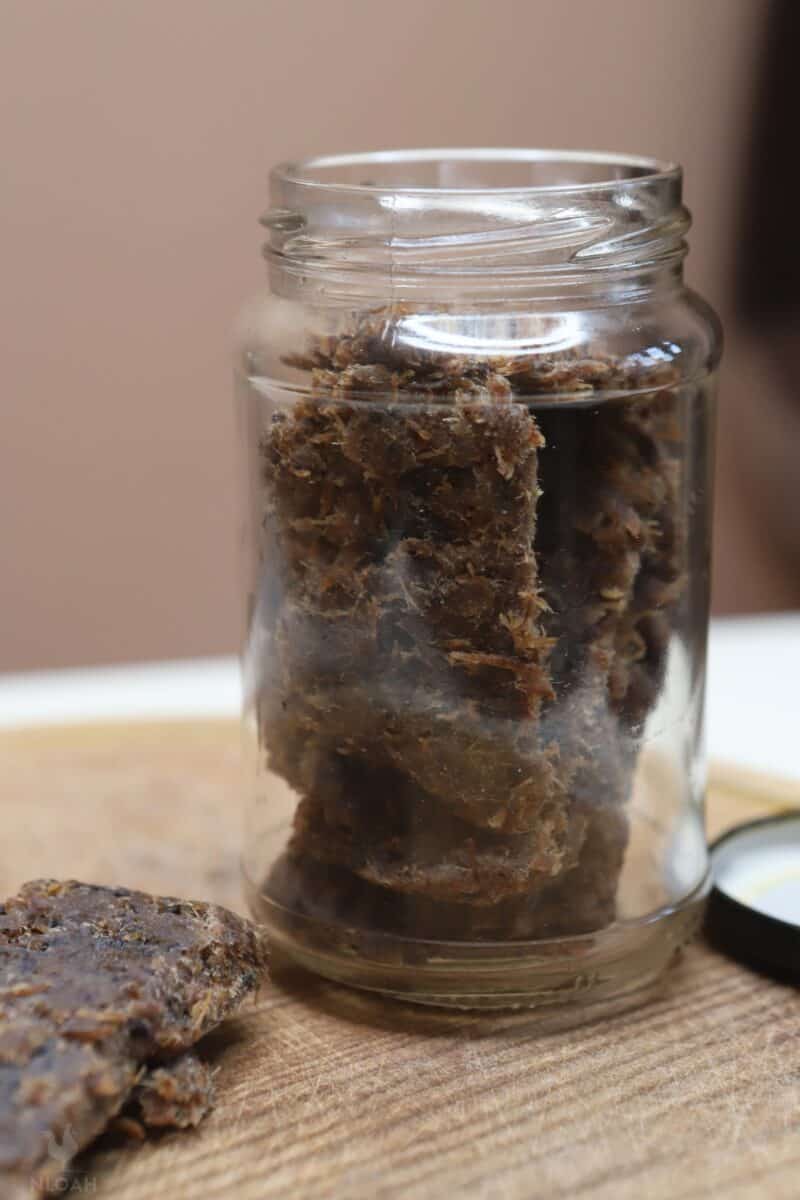Pemmican is a Native American survival dish that has been around for centuries. Used as a long-lasting, high-calorie food suitable for long journeys afield or in storage, pemmican is made of dried meat and rendered animal fat, and sometimes with other ingredients like berries or herbs.

Pemmican often served as a sort of survival ration for Native Americans and later settlers from Europe, and it is making a comeback with preppers today.
Making pemmican is an involved process and so naturally, people want to know how best to store it for max shelf life.
What’s the best way to store pemmican to make it last?
Pemmican is best stored wrapped in airtight bags, and kept in a cool, dark place Other viable methods include freezing, burying, canning and confit, or immersion in lard.
Pemmican is a recipe that can last, but the presence of fat as an ingredient means that careful storage is a must in order to keep it from going rancid.
Pemmican can be stored for long periods of time, years on end, but you must know what you are doing. And as you might guess there are a few methods that work better than others.
In this article, we will discuss the different ways to store pemmican so that it will last longer and also talk about the benefits and drawbacks of each method.
What is Pemmican, Exactly?
Pemmican is a mix of dried meat and rendered animal fat, often with other ingredients like berries or herbs added in for flavor.
The word “pemmican” comes from the Cree word “pimikan” which means “fatty meat”. Pemmican was originally created by Native Americans as a way to preserve meat for long journeys and times of scarcity.
It was an essential part of Native American life, and later became a staple for European settlers in North America as well.
Making pemmican begins with drying the meat, which can be done in a dehydrator or by hanging it in strips in front of a low fire.
Once the meat is dry, it is ground into a powder and mixed with melted fat, or tallow. The ratio of fat to meat can vary, but it is typically about 50/50.
Other ingredients like berries or herbs can be added at this point, and the mixture is then wrapped tightly in a flexible casing to cool and solidify. Once that is done, the pemmican is ready to portion out or store as is.
Once prepared, pemmican can be eaten as is, gently pan-fried in slices, or reconstituted with water or broth to make a sort of “jerky stew.” It is high in calories and protein, and because of the high-fat content, quite satiating compared to other rations.
Pemmican is making a comeback today with preppers and folks who are interested in survival skills since it is adaptable, calorie-dense, and generally pretty good if you make it right. In essence, everything you might want in a survival food!
That being said, compared to commercially produced survival fare, freeze-dried food, and other such products pemmican is devoid of artificial preservatives and sophisticated packaging techniques.
Despite how good the recipe and process generally are, it won’t last anywhere near as long as an MRE or a can of Spam unless you take the time to store it correctly.
The following methods are the best for that purpose.

1. Wrap and Seal
The overall best method for storing Pemmican. Simply wrap it up tightly in cling wrap or aluminum foil before sealing it tightly in a Ziploc bag. Then store it in a cool, dry place.
Any time you are trying to keep fatty foods like pemmican at room temperature, heat, light, and moisture are the enemies. This method will help to eliminate all three.
Keeping pemmican in your pantry might be okay, but depending on its location in the home and the level of climate control this might not be ideal.
A root cellar is tops, and even a dry and well-sealed basement can work. If you don’t have those options available, consider storing it in any other cool location where you keep survival supplies.
Conversely, areas that experience temperature swings or are naturally hot, humid, or in direct sunlight are a no-go.
That rules out garages, attics, out buildings, and any place near an appliance (they generate heat!).
The fridge is also not recommended as the constant opening and closing will cause moisture to enter the packaging and hasten spoilage.
2. Freezing
Freezing pemmican is one of the most certain and dependable ways to keep it fresh. So long as you know it is good going in, you can depend on it being good coming out.
Because of this, it is a great option for long-term storage as an emergency staple in your freezer or ice chest.
When freezing pemmican, you can use the same packaging methods as above or you can go one step further and vacuum seal it.
This isn’t strictly necessary, but if you have the equipment it does offer an extra layer of protection and can help to prevent freezer burn.
If using freezer bags, be sure to remove as much air from them as possible before sealing- bubbles mean troubles!
Another thing to keep in mind is that as the pemmican thaws it will rehydrate to a degree and this can often start the clock ticking on spoilage.
If you freeze pemmican to keep it long term, make sure you eat it in a timely fashion after thawing it, and don’t count on being able to keep it fresh too much longer.
3. Burying
It sounds crazy, but it’s true. You can bury pemmican to extend the shelf life- if you do it right!
This method is what was commonly used by Native Americans when they wanted to prolong the shelf life of pemmican.
By wrapping pemmican in animal skin or oiled cloth, and then burying it in dry soil with a layer of wood ash around it you can keep pemmican for a very long time.
This method works because it essentially keeps the pemmican in a dry, alkaline environment and seals it off from both oxygen and light. The wood ash also helps to wick away any moisture that might try to infiltrate and helps to repel pests.
To do this properly you will need to find a location where the soil is both dry and cool. A shady spot in the woods with good drainage will suffice.
And instead of animal skins or other primitive wrappings, you can make use of modern butcher paper and tightly sealing plastic or metal containers.
4. Confit
Confit is a method of cooking and preservation derived from the French word that means, generally, “preserved” or “to preserve”.
This method is where meat is salted and then cooked slowly in its own fat before being stored submerged in fat while inside an airtight container where the fat will keep it from spoiling by preventing air from reaching the meat.
You can do the same thing with pemmican after a little trial and error. To make this method work, you’ll need to first make the pemmican separately and then use a large quantity of the same type of fat to store it in a crock or jar with a tightly sealing lid.
Just get the fat hot enough to barely melt before submerging the pemmican in it and replacing the lid.

5. Canning
It is possible to prolong the shelf life of pemmican using traditional canning methods, but this is generally not recommended as it usually proves to be pretty fiddly.
Any mistakes or errors means the high-fat content of pemmican can go rancid relatively quickly. Nonetheless, with some diligence it is a viable method.
If you do choose to go this route, be sure to use food-grade cans and a pressure canner. This will help to ensure a better seal and will also help to kill any bacteria that might be present.
Pemmican should be canned while it is still warm and kept in a cool, dark place until you are ready to use it. Once opened, pemmican canned in this way will only keep for a few weeks before going bad.
Tom has lived and worked on farms and homesteads from the Carolinas to Kentucky and beyond. He is passionate about helping people prepare for tough times by embracing lifestyles of self-sufficiency.
